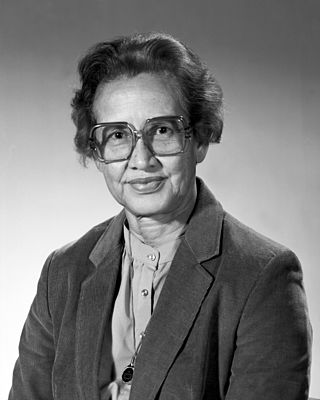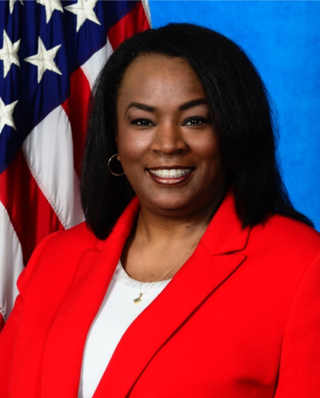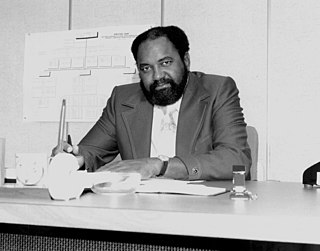
Sunspots are phenomena on the Sun's photosphere that appear as temporary spots that are darker than the surrounding areas. They are regions of reduced surface temperature caused by concentrations of magnetic flux that inhibit convection. Sunspots appear within active regions, usually in pairs of opposite magnetic polarity. Their number varies according to the approximately 11-year solar cycle.

The solar cycle, also known as the solar magnetic activity cycle, sunspot cycle, or Schwabe cycle, is a nearly periodic 11-year change in the Sun's activity measured in terms of variations in the number of observed sunspots on the Sun's surface. Over the period of a solar cycle, levels of solar radiation and ejection of solar material, the number and size of sunspots, solar flares, and coronal loops all exhibit a synchronized fluctuation from a period of minimum activity to a period of a maximum activity back to a period of minimum activity.

Nancy Jan Davis is a former American astronaut. A veteran of three space flights, Davis logged over 673 hours in space. She is now retired from NASA.

Solar minimum is the regular period of least solar activity in the Sun's 11-year solar cycle. During solar minimum, sunspot and solar flare activity diminishes, and often does not occur for days at a time. On average, the solar cycle takes about 11 years to go from one solar minimum to the next, with duration observed varying from 9 to 14 years. The date of the minimum is described by a smoothed average over 12 months of sunspot activity, so identifying the date of the solar minimum usually can only happen 6 months after the minimum takes place.

Annie Easley was an African American computer scientist and accomplished mathematician who made critical contributions to NASA's rocket systems and energy technologies over her 34-year career. As a black female in America during the 1950s, she faced heavy adversity throughout her career and was often underrepresented and disregarded. Despite these barriers Easley demonstrated perseverance and determination to make a name for herself in a line of work dominated by males. She demonstrated exceptional skills in mathematics, data analysis, and code development across projects focused on alternative energy sources, improved power systems, and launch capabilities enabling space communication and exploration.
Evelyn Boyd Granville was the second African-American woman to receive a Ph.D. in mathematics from an American university; she earned it in 1949 from Yale University. She graduated from Smith College in 1945. She performed pioneering work in the field of computing.

Solar cycle 24 is the most recently completed solar cycle, the 24th since 1755, when extensive recording of solar sunspot activity began. It began in December 2008 with a minimum smoothed sunspot number of 2.2, and ended in December 2019. Activity was minimal until early 2010. It reached its maximum in April 2014 with a 23 months smoothed sunspot number of 81.8. This maximum value was substantially lower than other recent solar cycles, down to a level which had not been seen since cycles 12 to 15 (1878-1923).

Jeanette Jo Epps is an American aerospace engineer and NASA astronaut. Epps received both her M. S. and Ph.D. degrees in aerospace engineering from the University of Maryland, where she was part of the rotor-craft research group and was a NASA GSRP Fellow. She was chosen for the 20th class of NASA astronauts in 2009, graduating in 2011. Epps currently serves as a member of the ISS Operations Branch and has completed analog astronaut missions, including NEEMO 18 and CAVES 19. She is the second woman and first African-American woman to have participated in CAVES. She is currently in space for a long duration mission on the ISS, after launch in 4 March 2024, as part of the SpaceX Crew-8 crew.

Creola Katherine Johnson was an American mathematician whose calculations of orbital mechanics as a NASA employee were critical to the success of the first and subsequent U.S. crewed spaceflights. During her 33-year career at NASA and its predecessor, she earned a reputation for mastering complex manual calculations and helped pioneer the use of computers to perform the tasks. The space agency noted her "historical role as one of the first African-American women to work as a NASA scientist".

Margaret Elaine Hamilton is an American computer scientist, systems engineer, and business owner. She was director of the Software Engineering Division of the MIT Instrumentation Laboratory, which developed on-board flight software for NASA's Apollo program. She later founded two software companies—Higher Order Software in 1976 and Hamilton Technologies in 1986, both in Cambridge, Massachusetts.

Fast, Affordable, Science and Technology Satellite-Huntsville 01 or FASTSAT-Huntsville 01 of the NASA. FASTSAT-HSV 01 was flying on the STP-S26 mission - a joint activity between NASA and the U.S. Department of Defense Space Test Program, or DoD STP. FASTSAT and all of its six experiments flying on the STP-S26 multi-spacecraft/payload mission have been approved by the Department of Defense Space and Experiments Review Board (USA-220).

Robin Neely Henderson is the Associate Director, Management, of the NASA Marshall Space Flight Center located in Huntsville, Alabama. She was named to become the center's Acting Director effective August 3, 2012, following the retirement of the previous director, Arthur E. Goldman, to take a private sector position. On September 25, 2012, NASA named Patrick Scheuermann as the center's new permanent director.

Christine Darden is an American mathematician, data analyst, and aeronautical engineer who devoted much of her 40-year career in aerodynamics at NASA to researching supersonic flight and sonic booms. She had an M.S. in mathematics and had been teaching at Virginia State University before starting to work at the Langley Research Center in 1967. She earned a Ph.D. in engineering at George Washington University in 1983 and has published numerous articles in her field. She was the first African-American woman at NASA's Langley Research Center to be promoted to the Senior Executive Service, the top rank in the federal civil service.

Solar cycle 25 is the current solar cycle, the 25th since 1755, when extensive recording of solar sunspot activity began. It began in December 2019 with a minimum smoothed sunspot number of 1.8. It is expected to continue until about 2030.

Dorothy Jean Johnson Vaughan was an American mathematician and human computer who worked for the National Advisory Committee for Aeronautics (NACA), and NASA, at Langley Research Center in Hampton, Virginia. In 1949, she became acting supervisor of the West Area Computers, the first African-American woman to receive a promotion and supervise a group of staff at the center.

Hidden Figures is a 2016 American biographical drama film directed by Theodore Melfi and written by Melfi and Allison Schroeder. It is loosely based on the 2016 non-fiction book of the same name by Margot Lee Shetterly about three female African-American mathematicians: Katherine Goble Johnson, Dorothy Vaughan, and Mary Jackson, who worked at NASA during the Space Race. Other stars include Kevin Costner, Kirsten Dunst, Jim Parsons, Mahershala Ali, Aldis Hodge, and Glen Powell.

Mary Jackson was an American mathematician and aerospace engineer at the National Advisory Committee for Aeronautics (NACA), which in 1958 was succeeded by the National Aeronautics and Space Administration (NASA). She worked at Langley Research Center in Hampton, Virginia, for most of her career. She started as a computer at the segregated West Area Computing division in 1951. In 1958, after taking engineering classes, she became NASA's first black female engineer.

Carla Denise Cotwright-Williams is an American mathematician who works as a Technical Director and Data Scientist for the United States Department of Defense. She was the second African-American woman to earn a doctorate in mathematics at the University of Mississippi.

Clyde Foster was an American scientist and mathematician. He worked for the Army Ballistic Missile Agency and then for NASA, and from 1975 to 1986 was the head of Equal Employment Opportunity at Marshall Space Flight Center in Huntsville, Alabama. He is credited with setting up training programs that allowed hundreds of African Americans to get the training necessary for positions and promotions at NASA in Huntsville, when Alabama was segregated and African Americans were denied those opportunities. To that purpose he also helped found a Computer Science program at his alma mater, Alabama A&M University, a historically black university, where he headed the Computer Science program while on loan from NASA. In 1981 he was awarded the Philip A. Hart Award for his "significant contribution toward improving urban and working environments".
Marion Lee Johnson is an American mathematician whose work was crucial to the landing of the Apollo 11 mission. She was a mathematician on the Boeing/NASA team, where she worked in preparing data for the vehicle impact trajectories. Her perfect score over 20 successful missions earned her a place on the Apollo/Saturn V Roll of Honor.



















